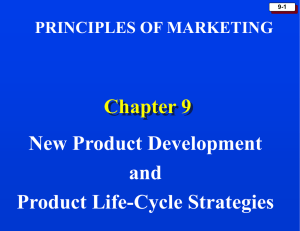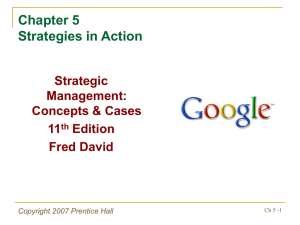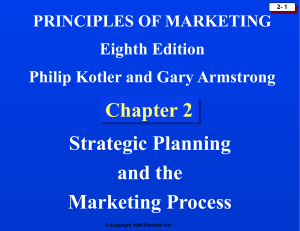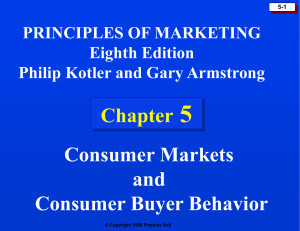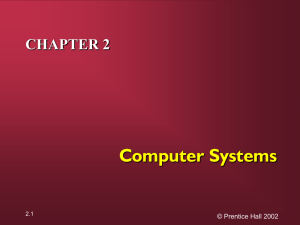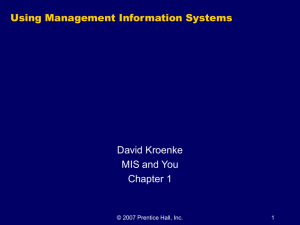Chapter 9: New Product Development and Product Life
advertisement
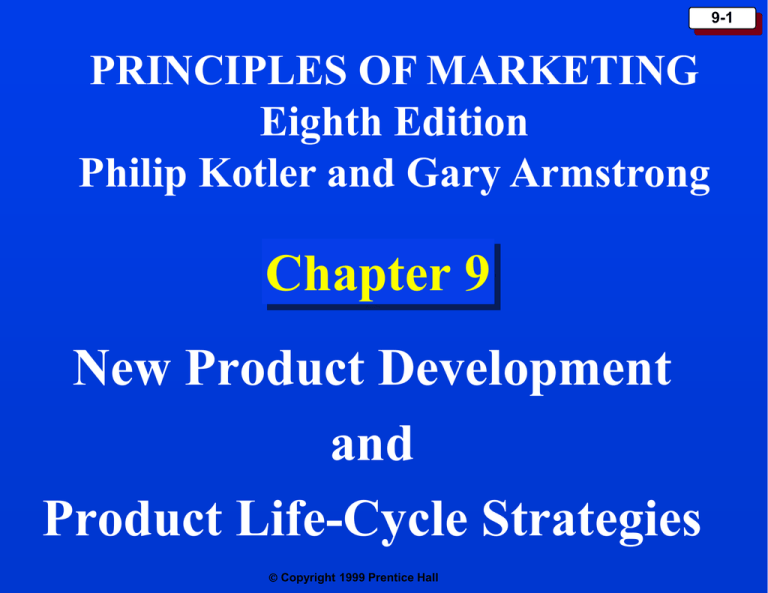
9-1 PRINCIPLES OF MARKETING Eighth Edition Philip Kotler and Gary Armstrong Chapter 9 New Product Development and Product Life-Cycle Strategies Copyright 1999 Prentice Hall New-Product Development Strategies Strategies for Obtaining New Product Ideas Acquired Companies Original Products Acquired Patents Product Improvements Acquired Licenses Product Modifications New Brands Copyright 1999 Prentice Hall 9-2 Causes of New Product Failures • Overestimation of Market Size • Product Design Problems • Product Incorrectly Positioned, Priced or Advertised • Costs of Product Development • Competitive Actions • To create successful new products, the company must: – understand it’s customers, markets and competitors – develop products that deliver superior value to customers. Copyright 1999 Prentice Hall 9-3 New Product Development Process Marketing Strategy Concept Development and Testing 9-4 Business Analysis Product Development Idea Screening Test Marketing Idea Generation Commercialization Copyright 1999 Prentice Hall 9-5 New Product Development Process Step 1. Idea Generation Idea Generation is the Systematic Search for New Product Ideas Obtained Internally and From: C U S T O M E R S C O M P E T I T O R S Copyright 1999 Prentice Hall D I S T R I B U T O R S S U P P L I E R S New Product Development Process Step 2. Idea Screening • Process to spot good ideas and drop poor ones as soon as possible. • Many companies have systems for rating and screening ideas which estimate: – – – – – Market Size Product Price Development Time & Costs Manufacturing Costs Rate of Return • Then, the idea is evaluated against a set of general company criteria. Copyright 1999 Prentice Hall 9-6 New Product Development Process Step 3. Concept Development & Testing 1. Develop Product Ideas into Alternative Product Concepts 2. Concept Testing - Test the Product Concepts with Groups of Target Customers 3. Choose the Best One Copyright 1999 Prentice Hall 9-7 New Product Development Process Step 4. Marketing Strategy Development Marketing Strategy Statement Formulation Part One Describes Overall: Target Market Planned Product Positioning Sales & Profit Goals Market Share Part Two Describes Short-Term: Product’s Planned Price Distribution Marketing Budget Part Three Describes Long-Term: Sales & Profit Goals Marketing Mix Strategy Copyright 1999 Prentice Hall 9-8 New Product Development Process Step 5. Business Analysis Step 6. Product Development Business Analysis Review of Product Sales, Costs, and Profits Projections to See if They Meet Company Objectives If No, Eliminate Product Concept If Yes, Move to Product Development Copyright 1999 Prentice Hall 9-9 New Product Development Process Step 7. Test Marketing Standard Test Market Full marketing campaign in a small number of representative cities. Controlled Test Market A few stores that have agreed to carry new products for a fee. Simulated Test Market Test in a simulated shopping environment to a sample of consumers. Copyright 1999 Prentice Hall 9-10 9-11 New Product Development Process Step 8. Commercialization Commercialization is the Introduction of the New Product into the Marketplace. When? Where? To Whom? Copyright 1999 Prentice Hall How? Speeding Up Development Simultaneous Step 1 Sequential 9-12 Step 2 Step 1 Step 2 Step 3 Step 3 Step 4 Step 4 Copyright 1999 Prentice Hall 9-13 Product Life Cycle Sales and Profits Over the Product’s Life From Introduction to Decline Sales and Profits ($) Sales Profits Time Product Development Introduction Growth Losses/ Investments ($) Copyright 1999 Prentice Hall Maturity Decline Introduction Stage of the PLC 9-14 Summary of Characteristics, Objectives, & Strategies Sales Low sales Costs High cost per customer Profits Negative Create product awareness and trial Marketing Objectives Product Offer a basic product Price Use cost-plus Distribution Build selective distribution Advertising Build product awareness among early adopters and dealers Copyright 1999 Prentice Hall Growth Stage of the PLC 9-15 Summary of Characteristics, Objectives, & Strategies Sales Rapidly rising sales Costs Average cost per customer Profits Rising profits Marketing Objectives Maximize market share Product Price Offer product extensions, service, warranty Price to penetrate market Distribution Build intensive distribution Advertising Build awareness and interest in the mass market Copyright 1999 Prentice Hall Maturity Stage of the PLC 9-16 Summary of Characteristics, Objectives, & Strategies Sales Peak sales Costs Low cost per customer Profits High profits Marketing Objectives Maximize profit while defending market share Product Price Distribution Advertising Diversify brand and models Price to match or best competitors Build more intensive distribution Stress brand differences and benefits Copyright 1999 Prentice Hall Decline Stage of the PLC 9-17 Summary of Characteristics, Objectives, & Strategies Sales Declining sales Costs Low cost per customer Profits Declining profits Marketing Objectives Reduce expenditure and milk the brand Product Phase out weak items Price Cut price Distribution Go selective: phase out unprofitable outlets Reduce to level needed to retain hard-core loyal customers Advertising Copyright 1999 Prentice Hall



